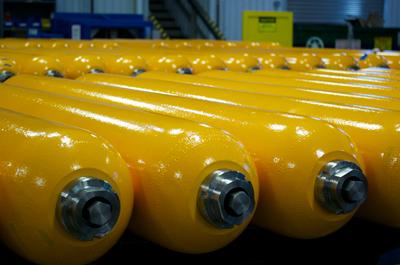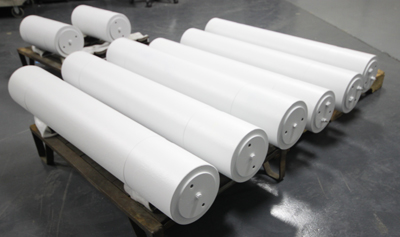Hydraulic accumulators are energy storage devices. Analogous to rechargeable batteries in electrical systems, they store and discharge energy in the form of pressurized fluid and are often used to improve hydraulic-system efficiency.

Bladder accumulators from Accumulators Inc.
An accumulator itself is a pressure vessel that holds hydraulic fluid and a compressible gas, typically nitrogen. The housing or shell is made of materials like steel, stainless steel, aluminum, titanium and fiber-reinforced composites. Inside, a moveable or flexible barrier—usually a piston or rubber bladder—separates the oil from the gas.
In these hydropneumatic units, hydraulic fluids only compress slightly under pressure. In contrast, gases can be compressed into smaller volumes under high pressures, and engineers take advantage of this property in accumulator design and application. In essence, potential energy is stored in the compressed gas and released on demand to force oil from the accumulator and into a circuit.
To use the device, the gas volume is first precharged—generally to around 80 to 90% of the minimum system working pressure. This expands the gas volume to fill most of the accumulator with only a small amount of oil remaining inside. In operation, the hydraulic pump raises system pressure and forces fluid to enter the accumulator. (Valves control oil flow in and out.) The piston or bladder moves and compresses the gas volume because fluid pressure exceeds the precharge pressure. This is the source of stored energy.
Movement stops when system and gas pressures are balanced. When a downstream action such as actuator movement creates system demand, hydraulic system pressure falls and the accumulator releases the stored, pressurized fluid to the circuit. When movement stops, the charging cycle begins again.
Three common types are bladder, piston and diaphragm hydraulic accumulators. Bladder accumulators typically have large ports that permit rapid fluid discharge and helps ensure that the device is relatively insensitive to dirt and contamination. A general rule is to mount bladder accumulators vertically, although they can also mount on their sides in low-cycle applications. Bladder type accumulators are usually designed to have a 4:1 pressure ratio (maximum pressure to gas-charged pressure) to protect the bladder from excessive distortion and material strain.
Experts tend to view bladder accumulators as the best general-purpose units. They come in a wide range of standard sizes, and good response characteristics make them well suited for shock applications. Depending on the design, a bladder can be easily replaced in the event of failure or damage.

Piston accumulators from Kocsis Technologies
A piston accumulator is much like a hydraulic cylinder without a rod. Similar to other accumulators, a typical piston accumulator consists of a fluid section and gas section, with the movable piston separating the two. Less common are piston accumulators that replace high-pressure gas with a spring or heavy weight to apply force to the piston.
Piston accumulators are generally recommended for large stored volumes—to 100 gallons or more—and can have high flow rates. Pressure ratio is limited only by the design, but they’re usually not recommended for shock applications. They are often built for rugged, heavy-duty applications. However, they are more sensitive to contamination that can damage the seals—although most piston accumulators are readily repaired by replacing the piston seals.
Diaphragm accumulators operate much like bladder accumulators. The difference is that instead of a rubber bladder, this version uses an elastic diaphragm to separate the oil and gas volumes. Diaphragm accumulators are economical, compact and lightweight devices that offer relatively small flow and volume—typically to around one gallon.
A diaphragm accumulator can handle higher compression ratios of up to 8 to 10:1 because the rubber barrier does not distort to the same degree as a bladder. They also enjoy wider mounting flexibility, are insensitive to contamination and quickly respond to changes in pressures, making them suited for shock applications.
Accumulators store energy that can be used to supplement pump flow, improve system response or serve as a back-up during power failure. They can also compensate for leakage or thermal expansion, and reduce vibration, pulsations and shock.
Filed Under: Mobile Hydraulic Tips, Slider